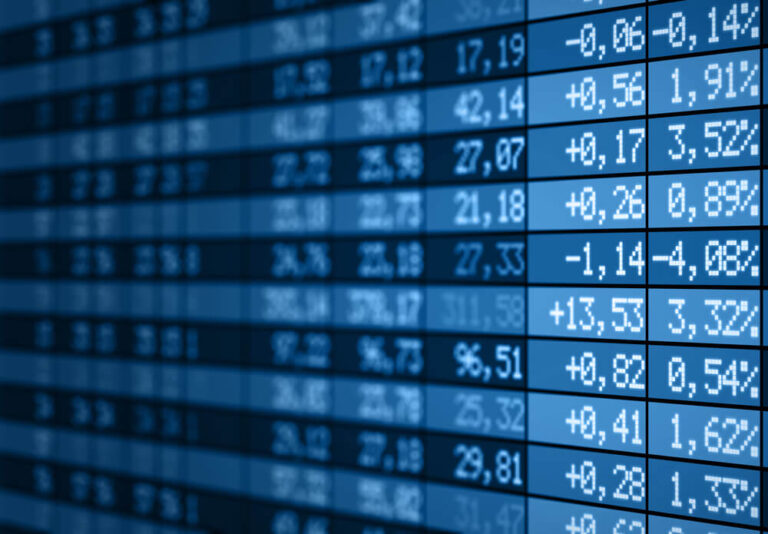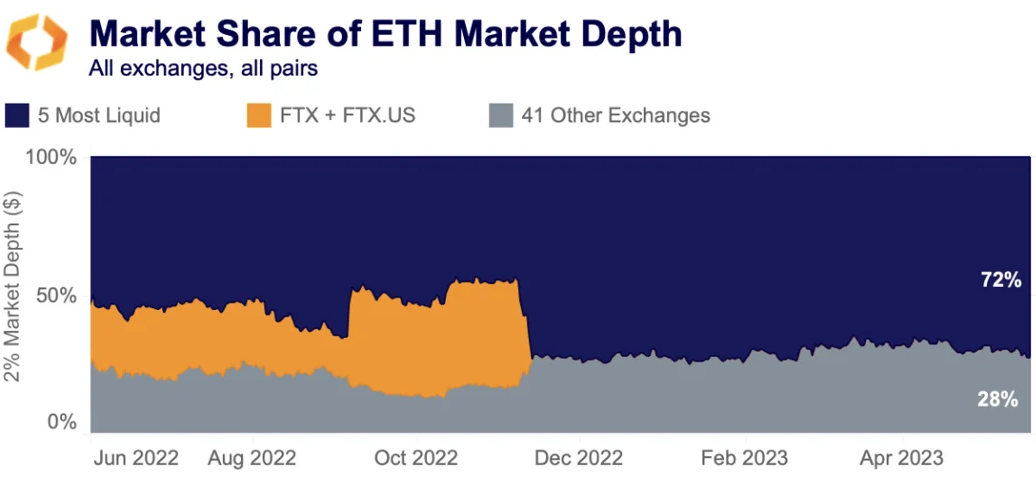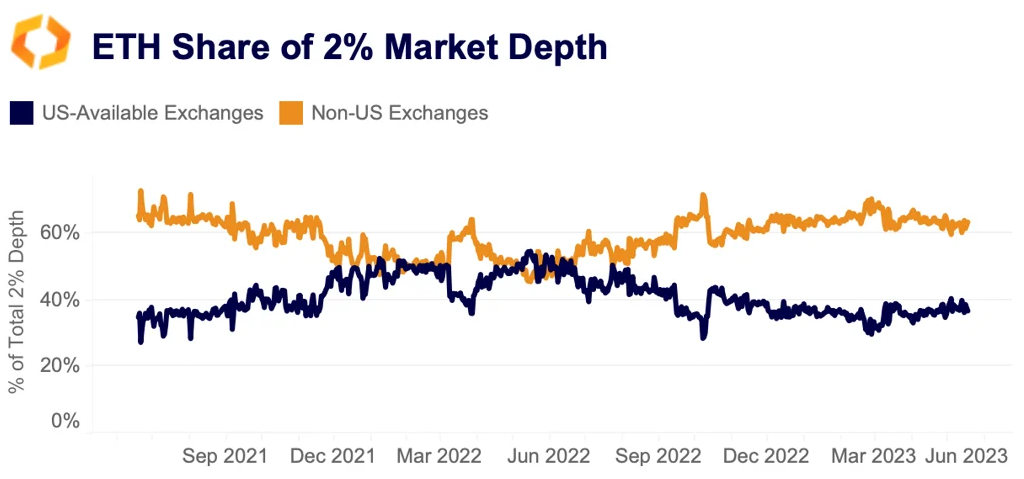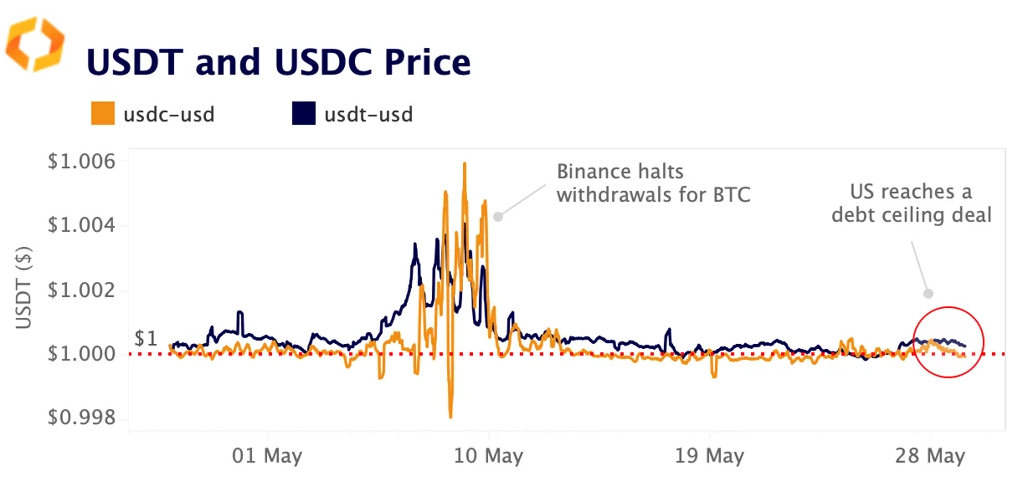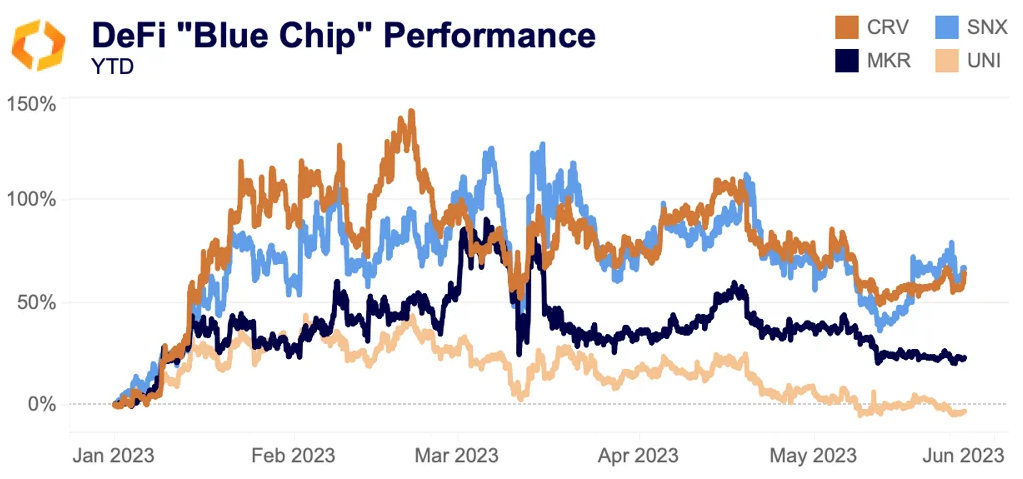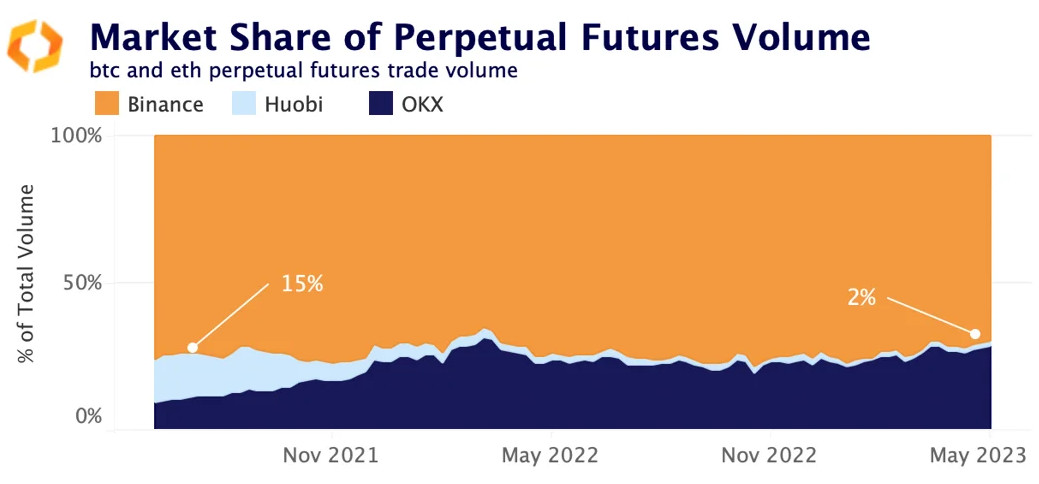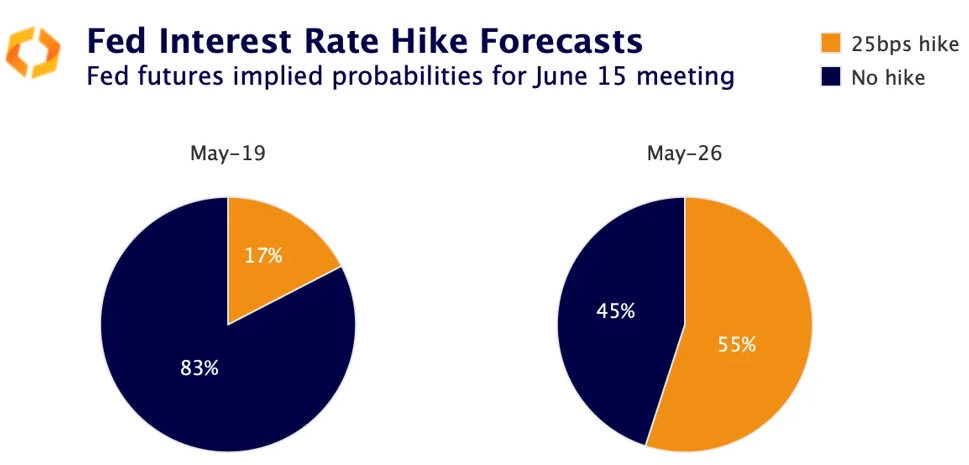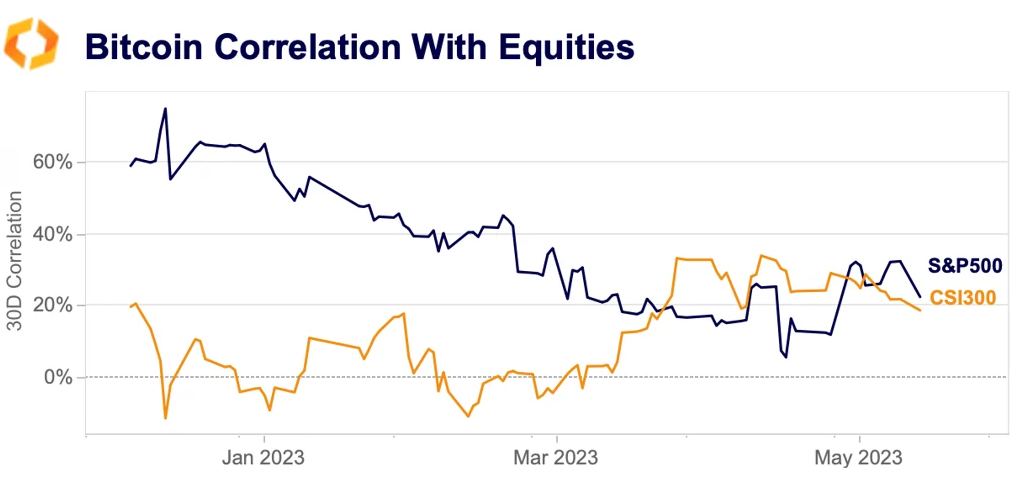A summarizing review of what has been happening at the crypto markets of the past week. A look at trending sectors, liquidity, volatility, spreads and more. The weekly report in cooperation with market data provider Kaiko.
Bitcoin gained some ground early on Monday as U.S. lawmakers reached a debt ceiling deal in principle. Hong Kong confirmed it will allow retail traders to trade certain crypto assets starting June while the Digital Currency Group (DCG) closed its trade execution and prime brokerage units, citing bear market and regulatory uncertainty. In this weeks Data Debrief, we explore:
- ETH liquidity concentration across price ranges and exchanges.
- OKX and Huobi ahead of the upcoming Hong-Kong re-opening.
72% of ETH liquidity is concentrated on 5 exchanges
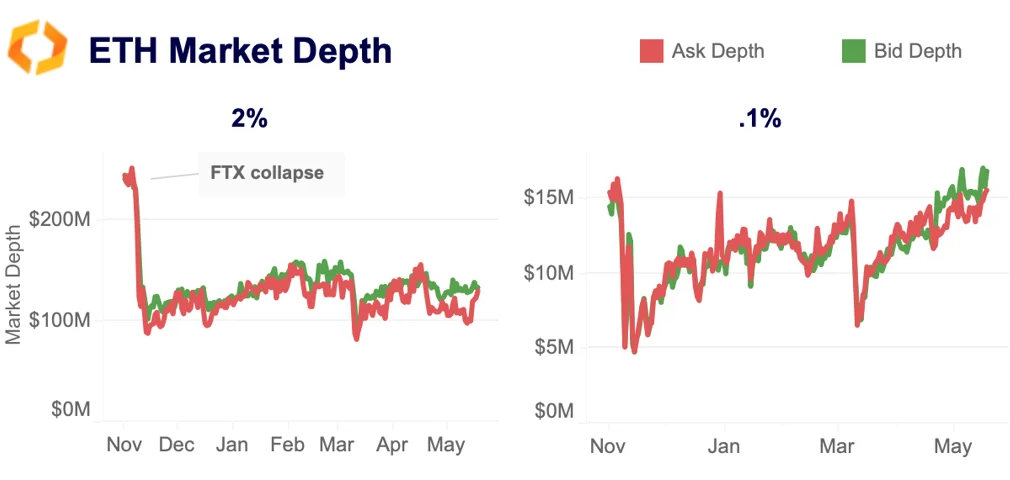
Since the collapse of FTX last year, there has been little good news on the liquidity front for crypto assets. The shutdown of the Signet and SEN fiat settlement networks in the US severely impacted market makers operational efficiency. This can be seen in 2% market depth for ETH, which dipped in March and has failed to recover to pre-FTX levels. However, .1% depth, which measures liquidity immediately around the mid price, is back above pre-FTX levels as market makers become more comfortable offering liquidity again around a tight range.
Overall, order book liquidity has become very concentrated on only a few exchanges since the collapse of FTX. 72% of ETH market depth exists on just 5 exchanges: Binance, Bitfinex, OKX, Coinbase and Kraken. All other exchanges (41) account for just 28% of market depth. Before FTX collapsed, the exchange and U.S. counterpart accounted for a high of nearly 40%.
While liquidity is becoming more concentrated across a handful of exchanges, it is also moving away from the U.S in the last year. The share of market depth on U.S-available exchanges is at around 40%, down from a high of 54% hit right before the Terra collapse last May. Global exchanges are benefiting from the regulatory crackdown, attracting market makers that don't want to get caught up in the uncertainty.
Going forward, we could expect a continued consolidation of liquidity on just a handful of exchanges for all assets, not just ETH, as the exchange space struggles to attract market makers amid an ongoing bear market.
Stablecoin prices are recovering
The two largest stablecoins by market cap closed the week trading at a slight premium as the U.S. debt ceiling drama moved closer to a resolution. Interestingly, while stablecoins were heavily impacted by spillovers from the regional banking crisis, both USDT and USDC saw little to no volatility over the past two weeks, despite the ongoing debt ceiling drama. This suggests that a U.S. default was not in the markets’ base case and mirrors a muted reaction in equity markets, with the Nasdaq up 8% this month amid booming AI-related stocks.
It is notable however that, USDT and USDC have increasingly been trading in tandem during periods of market stress. Both stablecoins rose above $1 earlier this month when Binance temporarily halted withdrawals for Bitcoin (BTC) due to network congestion issues. This suggests that USDC could have recovered some safe-haven appeal as U.S. banking troubles ebbed.
CRV and SNX lead DeFi “blue chips”
New rollouts have propelled Curve DAO (CRV) and Synthetix Network (SNX) to be the best performers amongst older Ethereum DeFi stalwarts. CRV has been boosted by the release of crvUSD, a new stablecoin utilizing a new collateral and liquidation method; Staked Frax ETH (sfrxETH) is the first collateral asset, with more to be added soon. Additionally, updates to its TriCrypto pool could soon help Curve capture some of Uniswap’s volume market share.
Synthetix, meanwhile, has rallied as new trading incentives on Optimism helped propel its derivatives trading exchange Kwenta to become one of the largest decentralized derivatives exchanges by volume. Uniswap’s token UNI is flat this year despite the exchange expanding to new chains and maintaining its dominance on Ethereum. Maker DAO (MKR) has also struggled amidst debates about the future of the protocol.
OKX well positioned for Hong Kong re-opening
Last week Hong Kong's financial regulator, SFC, announced that its new licensing regime for virtual assets will take effect on June 1st allowing for retail investors to buy certain crypto assets. This, along with the coverage in Chinese state media (which was later removed) has increased the optimism that a portion of China's substantial $1.4bn household savings could flow into the crypto market.
China has been engaged in crackdowns on the crypto industry since 2017 with several exchanges officially exiting the country and halting registrations for mainland Chinese users. OKX and Huobi, which were founded in Hong Kong and China respectively, were among the main losers of the country’s adverse stance on crypto, losing significant market share to global rivals such as Binance.
However, while both exchanges have seen their market share relative to Binance shrink, OKX has fared significantly better, helped by its burgeoning derivatives market. Huobi spot market share fell fourfold from 25% to 5% since July 2021 while OKX has seen a smaller decline from 16% to 10% over the same period. Looking at derivatives markets, OKX has actually managed to increase its market share in BTC and ETH perpetual futures three-fold from 9% to 30%.
Although optimism surrounding China's economic reopening has waned compared to earlier this year, the regulatory clarity provided by Hong Kong's licensing regime could unlock substantial pent-up demand for certain crypto assets and platforms. Despite the official ban on crypto trading, Chinese and Hong Kong users still represented 11% of FTX's user base, as revealed in the bankruptcy filings of the failed exchange. This is nearly as much as the combined user bases of Singapore, Taiwan, and Korea.
Bitcoin gains ground
Bitcoin rose above $28k early on Monday as the U.S. avoided a disorderly debt ceiling episode. While this could have a short-term positive impact on markets, the outlook for liquidity has worsened. Signs that U.S. inflation is accelerating again, combined with relatively robust corporate earnings and a tight labor market, pushed the likelihood of an 11th consecutive rate hike in June to 55% last week, up from 17% a week earlier.
Furthermore, after a deal is reached, the U.S. Treasury is expected to step up debt issuance to replenish its cash balance at the Fed – the so-called Treasury General Account (TGA). The TGA hit its lowest level since 2017 last week as the U.S. has been spending its funds at the Fed to avoid issuing new debt after the ceiling of $31.4tn was reached on Jan 19.
Replenishing the TGA will effectively remove liquidity from the market exacerbating the impact of the ongoing Fed's balance sheet reduction (quantitative tightening ) which already drains up to $95bn per month.
Bitcoin’s correlation with Chinese equites increases
The correlation between BTC and Chinese equities (CSI 300) has strengthened this year, although it remains relatively low at approximately 20%. Interestingly, the correlation between BTC and US equity markets has decreased, reaching a multi-year low in April. It is worth noting that crypto is much less integrated in the Chinese financial system relative to the U.S. mainly due to China's strict stance on cryptocurrencies in recent years. This trend suggests that the regulatory and economic reopening in China is increasingly influencing crypto market sentiment.

